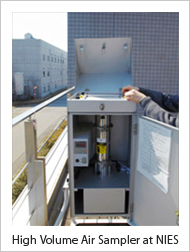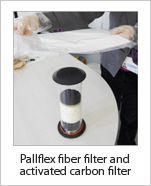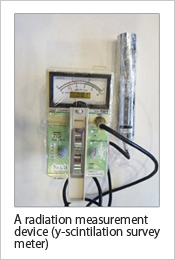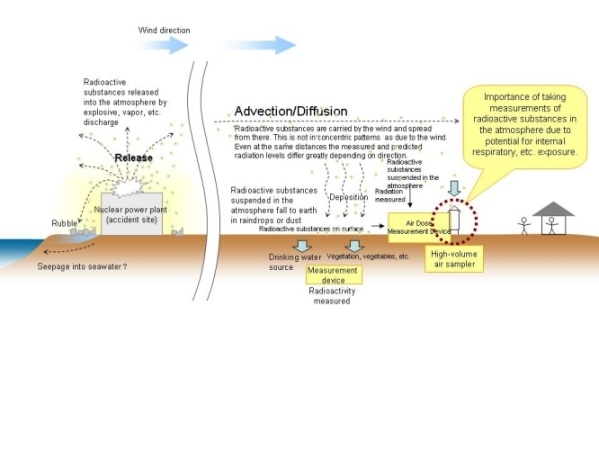Ⅰ-6. (1) Tsukuba City radioactive substances and radiation measurements
1. Measurement of atmospheric radioactive substances in collaboration with the High Energy Accelerator Research Organization (KEK)

Since the afternoon of March 15, 2011, we have measured the types and densities of atmospheric radioactive substances in Tsukuba City in collaboration with the High Energy Accelerator Research Organization (KEK) who are also based in Tsukuba City.
We take atmospheric samples on the NIES grounds using an instrument called a High Volume Air Sampler (pictured). This instrument has a pallflex fiber filter for catching particles in the atmosphere and an activated fiber filter for capturing gaseous particles. The High Energy Accelerator Research Organization then analyses the materials captured using these filters.
The measurement results which have been achieved to date are disseminated via the homepage (below) of the High Energy Accelerator Research Organization, with new data being constantly updated. Both parties will continue this work to ensure the accurate measurement and dissemination of data.
-
See: Radioactive substance measurements (High Energy Accelerator Research Organization Homepage)
Measurement method

- Atmospheric sampling is carried out continuously over a period of 2 days per session, equivalent to an atmospheric pressure of 850-1700m3.
- The effects of these substances are established with the aid of the wind - as such a slightly raised vantage point is chosen.
- The pallflex fiber filter is in the part shown in the picture which the person is handling. A tarpaulin is fitted over the device before sampling is carried out.
- The activated carbon filter is found in the cylinder portion of the device.
- The atmosphere passes in order from the upper portion of the instrument, through the pallflex fiber filter and then the activated carbon filter so that the materials in the atmosphere can be captured (Picture).
Explanation and background to this measurement
- Radioactive materials are carried through the atmosphere on the wind. At a relative close proximity to the nuclear facilities, high levels of radiation were measured, especially in the rubble created by the explosions.
- While radiation measurement data in the vicinity of the nuclear power plant has been verified, any radiation measured in the environment has not arrived directly from the effected facilities, but is rather in the form of radioactive substances carried through the atmosphere on the wind.
- The radiation detected in vegetation, tap water, etc., has been carried to each measurement location and fallen in the form of precipitation which adheres or is absorbed to vegetation or has been washed into waterways as rainwater.
Keys to the proper interpretation of information
Radioactivity means materials have the potential to emit radiation. However, in the case of radioactive leaks radiation indicates that radioactive materials have left the facilities themselves. The key to interpreting the data is in being able to distinguish between radiation, radioactivity, and radioactive materials.
Also “hourly radiation level” (dose rate) data cannot be directly compared with “a single radiation dose level” as might be experienced at a medical check-up, but it is rather appropriate to compare this aggregate over the time period in which exposure occurred. (Fukushima Prefecture, Integrated Dose Data)
It is also important to distinguish between a radiation dose from outside the body originating from radioactive materials in the environment (external exposure) and radiation from radioactive materials which have been taken into the body by means of inhalation or ingestion (internal exposure).
Importance of directly measuring the radioactive substances in the atmosphere having considered the influence of internal exposure

NIES has carried out environmental sampling using a high-volume air sampler. After collecting the gases and nanoparticles suspended in the atmosphere and measuring the variety and strength of radioactive substances in these samples, calculations using the compiled data are made by the High Energy Accelerator Research Center (KEK).
It is important to directly sample radioactive substances in the environment, and that the consolidated data takes into account the influence of internal exposure. Many institutions present results purporting to be measurements of atmospheric radiation. However, this is not radiation in the atmosphere but also includes radiation from radioactive materials on the ground.
2. Measuring radiation in collaboration with educational facilities in Tsukuba City
On May 27, 2011, in response to a request from the Tsukuba city authorities, NIES began to collaborate in the measurement of radiation levels in 132 places in schools throughout the city. These efforts benefited from the participation of 13 experts from the High Energy Accelerator Research Organization (KEK); the National Institute of Advanced Industrial Science and Technology (AIST); Tsukuba University; and the National Institute for Material Sciences (NIMS).
NIES dispatched two of its employees to assist in the undertaking, in addition to lending two devices for the measurement of radiation. Tsukuba cities nursery, kindergarten and primary schools were divided into 13 groups and the levels of radiation in schoolyards etc, were measured. Measurement results for radiation levels in schools and kindergartens in Tsukuba City were published on the homepage of the Tsukuba City local authorities.
- Great East Japan Earthquake Information Page
- Ⅰ-1.Appropriate treatment and disposal of disaster waste and waste contaminated by radioactive substance
- Ⅰ-2. Clarifying behaviors for radioactive substances in multimedia (atmosphere, soil, water, plants, organisms and ecosystems, etc.)
- Ⅰ-3. Studies and projections on environmental change originating from the disaster and associated effects
- Ⅰ-4. Details of research outcomes presented at the NIES Public Symposium
- Ⅰ-5. An Overview of Research on Disaster Environment
- Ⅰ-6. (1) Tsukuba City radioactive substances and radiation measurements
- Ⅰ-6. (2) Research outcomes etc., from NIES researchers (Presented prior to the occurrence of the Great East Japan Earthquake)
- Ⅰ-6. (3) Kankyo Tenbodai (Environmental Observatory), search service for disaster information relating to environment in environmental information media
- Ⅱ. Information Sources Related to the Disaster
- An Overview of Research on Disaster Environment
